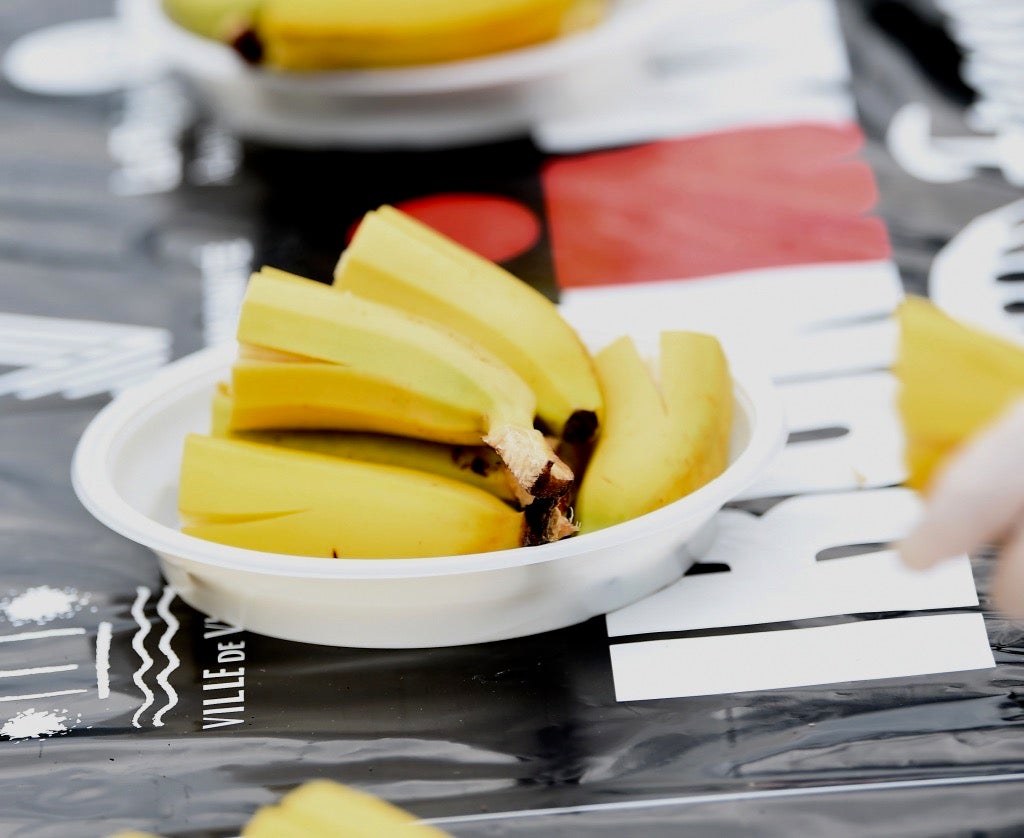Should You Ditch Sports Nutrition Products for Real Food?

Photo by Patrik Lundin/Getty Images for Ironman
While the day of the prepackaged gel and bar hasn’t yet come and gone, and likely won’t ever disappear, there is a broad movement in sports nutrition toward once again embracing real food. More people are becoming aware of the potential benefits of ditching some of the store-bought stuff for made-with-love forms of performance nutrition that keep them naturally fit.
It Works
In my book Rocket Fuel, I share a little of the science that supports the use of food you find in bulk bins and produce aisles to bolster endurance and strength to the same degree (if not more!) than the stuff created by the white coats in their labs.
Case in point: A Journal of the International Society of Sports Nutrition study found that raisins were just as effective as carbohydrate-based energy chews at keeping runners’ endurance levels up. That’s why you’ll find these little nuggets of energy in one of my homemade Energy Shots. Heck, even a lowbrow bowl of cereal and milk has been found to be great recovery fuel.
Nutrition Upgrade
Even if you’re not taking your nutrition seriously, it’s likely much of your competition is. This fact alone can be enough to ensure that they leave you playing catch-up. You can train until your legs fall off, but if you don’t have your nutrition on point, your fitness gains during training are going to be subpar and it’s likely you’ll have a tough race.
I often trumpet that one of the most important benefits of giving your pots and pans a workout by making your own edible energy is that it’s another opportunity to take in a wider variety of the vital nutrients that an active body requires to perform its best and yield quicker training results.
Keeping It Real
Flip over a packaged sports nutrition product and you’ll likely wish you majored in food chemistry. Although items on the market increasingly rely on healthy ingredients that even your grandma would recognize, the norm is still to pack them full of a minefield of mystery items, including food colorings, emulsifiers, “natural flavors,” fractionated oils (what?), and artificial sweeteners. I don’t know about you, but soy protein nuggets and carnauba wax are not something I have in my pantry or necessarily want to put in my body on a regular basis. Funny how these products can still be labeled “natural.”
Troublemakers
For better or worse, an increasing number of athletes are steering clear of certain items such as lactose and gluten. In certain cases, this is a must in response to conditions such as lactose intolerance or celiac disease. Crafting your own fuel affords you better control over sidestepping possible food allergens or ingredients that simply don’t fit into the dietary lifestyle you have embraced.
In Good Taste
Relying heavily on packaged energy-food products can lead to a serious case of palate fatigue. After all, there are only so many cloyingly sweet gels and cat food–like meat bars you can stomach before you want to tap out. Also, the same tastes and textures seem to be pumped out again and again, which can get old quick. Really, another peanut butter and chocolate bar? An underappreciated benefit of homemade fuel is that it can promote better fueling by making you actually want to eat the stuff—and leave your workouts seeming a little more gourmet.
Variety Is the Spice of Life
When you make your own performance fuel, you can have fun experimenting with all sorts of exciting and innovative ingredients to create flavors and textures. That’s why I spent countless hours in the kitchen creating the recipes for Rocket Fuel that not only provide useful calories but also push the boundaries of what athletes are accustomed to eating when on the move or in need of recovery sustenance. Fueling your active lifestyle can be so much more than smoothies and bars.
Save Cash
Walk into any bike, running or outdoor-gear shop and you’ll inevitably be greeted by displays of so-called sports nutrition products promising to boost your game. However, their convenience comes with a price tag. Although the occasional use won’t break the bank, when you consider that each gel can set you back a couple bucks and some bars ring in at a hefty $4, relying solely on store-bought packaged energy foods can put a serious dent in your gear or race budget. Making your own fitness fuel can leave you more wiggle room for race entry fees or that bucket list bike trip to the Alps.
Eat Better Overall
A strange thing happens when people decide to take the time to craft their own performance fuel. All of the sudden, they start to get excited about cooking again and increasingly trade in trips to the drive-thru for old-fashioned home cooking. Maybe a little inspiration is all you need to avoid settling for a frozen packaged burrito come the dinner bell!
Taste the Reward
Having an arsenal of go-to fuel recipes can have the positive side effect of encouraging you to exercise with greater frequency. After all, enjoying delicious fuel only really works if you also keep active. I will happily work up a sweat if I can take a bite out of some Salted Quinoa Almond Fudge Cups afterward or bring along a bagful of Sushi Rolls (both from the book).
[velopress cta=”Shop now” align=”center” title=”Buy the Book”]